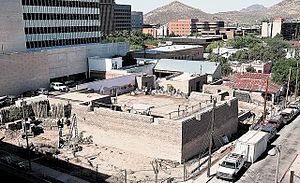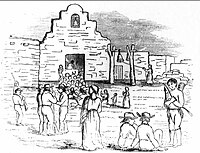Presidio San Agustín del Tucsón: Difference between revisions
Az81964444 (talk | contribs) |
Az81964444 (talk | contribs) |
||
| Line 27: | Line 27: | ||
===Spanish Period=== |
===Spanish Period=== |
||
A [[company]] of [[Spanish Army]] [[soldier]]s founded Tucson in 1775 and completed it in 1783, they came from the [[Presidio San Ignacio de Tubac]] which is roughly sixty miles south of Tucson. The new presidio was chosen to be placed on the right side of the [[Santa Cruz River (USA)|Santa Cruz River]] near |
A [[company]] of [[Spanish Army]] [[soldier]]s founded Tucson in 1775 and completed it in 1783, they came from the [[Presidio San Ignacio de Tubac]] which is roughly sixty miles south of Tucson. The new presidio was chosen to be placed by [[Hugo O'Connor]], an [[Ireland|Irish]] [[mercenery]] working for Spain. The location was on the right side of the [[Santa Cruz River (USA)|Santa Cruz River]] near what was then a [[Pima]] [[pueblo]]. The fort was constructed to be in the shape of a large square, walls with [[bastions]] for corners. Over time the fort was built stronger and stronger due to [[First Battle of Tucson|several]] [[Apache]] [[Second Battle of Tucson|attacks]]. By the time the Apache major threat was over in the late 1880's, the walls were mostly gone. The Spanish built the fort to protect communication and trade routes across northern [[Sonora]] and southern [[Alta California]], now the present day states of [[Arizona]], [[Mexico]] and [[California]]. [[Captain (land)|Captain]] [[Juan Bautista de Anza]] commanded the construction of the fort and about fifty to sixty [[heavy cavalry]] men. After the structure began to take shape the families of the predidio garrison were sent for. When they arrived they established the settlement. [[Jacal]]s sprang up both inside and outside of the walls, all of the buildings were origionally built of [[adobe]] [[brick]] and [[mesquite]] tree limbs. The San Augustin church was also built. Three hundred years ago the Santa Cruz flowed well and several [[irrigation]] [[canal]]s were dug around the presidio. They were used for the [[citrus]] [[grove (nature)|grove]]s and other crops grown to support the population. Tucson flourished under Spanish reign but the population never reached more than 1,000, not until the [[United States]] controlled the city. |
||
The colony managed to grow with the help of the fort and it's occupants who launched several expeditions into [[Indian country]] to fight the [[Seri]]'s, [[Opata]]s, [[Papago]] and primarily the [[Apache]]. Not all native tribes were hostile, throughout the Spanish period the [[Pima]]'s were mostly peaceful with the exception of [[Pima Revolt|two]] [[Pima Revolt of 1751|rebellion]]s long before Fort Tucson was constructed. Over it's use several different native american groups lived in Tucson and the surrounding villages of Tubac, [[Tumacacori, Arizona|Tumacacori]] and elsewhere. Groups of Pimas Apaches, Papago, Oaptas, Seris and others all eventualyy lived at the Spanish settlements in the Santa Cruz River Valley. Many of the men bacame [[scout]]s for the Spanish Army during the wars against the hostile tribes. At one point the entire garrison of Fort Tubac consisted solely of Papago warriors. By the time the Spanishe period ended in 1821, most of the native groups were hostile again old Spanish frontier settlements were being abandoned. The population of Tucson and Tubac, reached a population each of about 350 at their peaks. Tumacacori had about 100 Spaniards during it's best years, the remaining population of the the presidios were native Americans who usually outnumbered the Spanish by hundreds. Fort Tubac was abandoned several times over 110 years due to repeated attackes at or near the fort. The garrisons remained relatively small, usually [[cavalry]] and some [[artillery]]. [[Captain]] [[Allande]] took command of Tucson after Captain Anza, Allande commanded Fort Tucson during for diffierent attacks. He also commanded many of the advances into Apacheria. Native warriors also contributed to Fort Tucson's defense several times during it's history of fighting Apaches, sometimes because the natives allied with the Spanish were already enemies with the Apache. The wars grew into sort of a stalemate; eventually the Spanish growth in the presidio topped off resulting in the small company size garrisons. The Spanish at any given point had fewer than 300 of their own men in all their presidios and settlements. The contingents of native warriors which helf the Spanish were typically very small, about fifteen men. The Pimas contributed dozens of warriors to Captain Allande during the years. |
|||
| ⚫ | |||
| ⚫ | |||
[[File:Tucson in 1864.gif|left|thumb|200px|''Tucson in 1864.'']] |
[[File:Tucson in 1864.gif|left|thumb|200px|''Tucson in 1864.'']] |
||
[[File:Tucson Stone Ave year 1880.jpg|200px|left|thumb|''Tucson in 1880''.]] |
[[File:Tucson Stone Ave year 1880.jpg|200px|left|thumb|''Tucson in 1880''.]] |
||
Revision as of 22:21, 4 May 2010
| Fort Tucson | |
|---|---|
| Tucson, Arizona | |
 The recontructed northeastern bastion of Fort Tucson in 2009. | |
| Type | Army fortification |
| Site information | |
| Controlled by | |
| Condition | tourist attraction |
| Site history | |
| Built | 1775-1783 |
| Built by | |
| In use | 1776 to 1886 |
| Materials | adobe, mesquite, earth |
| Battles/wars | Spanish-Apache War *First Battle of Tucson *Second Battle of Tucson *Third Battle of Tucson *Fourth Battle of Tucson Mexican-American War War *Capture of Tucson (1846) Apache Wars American Civil War *Capture of Tucson (1862) |
| Garrison information | |
| Occupants | |
Presidio San Augustin del Tucson or Fort Tucson is a presidio located within Tucson, Arizona. The fortress was built by Spanish conquistadors during the eighteenth century. The presidio was the founding structure of what became Tucson. The origional walls and bastions vanished over the years though a reconstructed bastion was built in 2008 over foundations of the origional structure.
History
Spanish Period
A company of Spanish Army soldiers founded Tucson in 1775 and completed it in 1783, they came from the Presidio San Ignacio de Tubac which is roughly sixty miles south of Tucson. The new presidio was chosen to be placed by Hugo O'Connor, an Irish mercenery working for Spain. The location was on the right side of the Santa Cruz River near what was then a Pima pueblo. The fort was constructed to be in the shape of a large square, walls with bastions for corners. Over time the fort was built stronger and stronger due to several Apache attacks. By the time the Apache major threat was over in the late 1880's, the walls were mostly gone. The Spanish built the fort to protect communication and trade routes across northern Sonora and southern Alta California, now the present day states of Arizona, Mexico and California. Captain Juan Bautista de Anza commanded the construction of the fort and about fifty to sixty heavy cavalry men. After the structure began to take shape the families of the predidio garrison were sent for. When they arrived they established the settlement. Jacals sprang up both inside and outside of the walls, all of the buildings were origionally built of adobe brick and mesquite tree limbs. The San Augustin church was also built. Three hundred years ago the Santa Cruz flowed well and several irrigation canals were dug around the presidio. They were used for the citrus groves and other crops grown to support the population. Tucson flourished under Spanish reign but the population never reached more than 1,000, not until the United States controlled the city. The colony managed to grow with the help of the fort and it's occupants who launched several expeditions into Indian country to fight the Seri's, Opatas, Papago and primarily the Apache. Not all native tribes were hostile, throughout the Spanish period the Pima's were mostly peaceful with the exception of two rebellions long before Fort Tucson was constructed. Over it's use several different native american groups lived in Tucson and the surrounding villages of Tubac, Tumacacori and elsewhere. Groups of Pimas Apaches, Papago, Oaptas, Seris and others all eventualyy lived at the Spanish settlements in the Santa Cruz River Valley. Many of the men bacame scouts for the Spanish Army during the wars against the hostile tribes. At one point the entire garrison of Fort Tubac consisted solely of Papago warriors. By the time the Spanishe period ended in 1821, most of the native groups were hostile again old Spanish frontier settlements were being abandoned. The population of Tucson and Tubac, reached a population each of about 350 at their peaks. Tumacacori had about 100 Spaniards during it's best years, the remaining population of the the presidios were native Americans who usually outnumbered the Spanish by hundreds. Fort Tubac was abandoned several times over 110 years due to repeated attackes at or near the fort. The garrisons remained relatively small, usually cavalry and some artillery. Captain Allande took command of Tucson after Captain Anza, Allande commanded Fort Tucson during for diffierent attacks. He also commanded many of the advances into Apacheria. Native warriors also contributed to Fort Tucson's defense several times during it's history of fighting Apaches, sometimes because the natives allied with the Spanish were already enemies with the Apache. The wars grew into sort of a stalemate; eventually the Spanish growth in the presidio topped off resulting in the small company size garrisons. The Spanish at any given point had fewer than 300 of their own men in all their presidios and settlements. The contingents of native warriors which helf the Spanish were typically very small, about fifteen men. The Pimas contributed dozens of warriors to Captain Allande during the years.

and Tumacacori remained at about a 100

Mexican Period
American Period
References
- Cooper, Evelyn S, (1995), Tucson in Focus: The Buehman Studio, Arizona Historical Society, Tucson. ISBN 0-910037-35-3.
- Walker A Tompkins, Santa Barbara History Makers McNally & Loftin, 1983 p.105. ISBN 0-87461-059-1
- Bancroft, Hubert Howe, (1888), History of Arizona and New Mexico, 1530–1888. The History Company, San Francisco.
- Dobyns, Henry F, 1976, Spanish Colonial Tucson, University of Arizona Press, Tucson. ISBN 0-8165-0546-2.
- Drachman, Roy P, 1999, From Cowtown to Desert Metropolis: Ninety Years of Arizona Memories Whitewing Press, San Francisco. ISBN 1-888965-02-9
